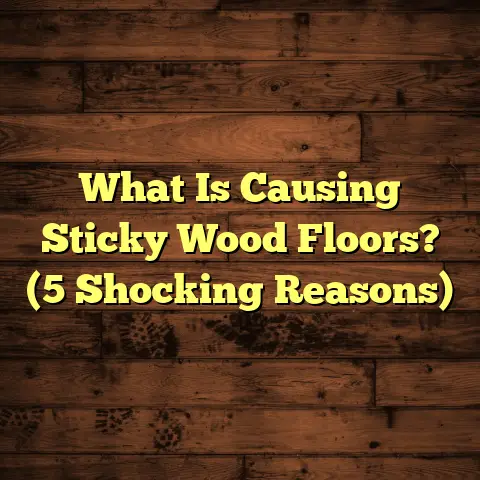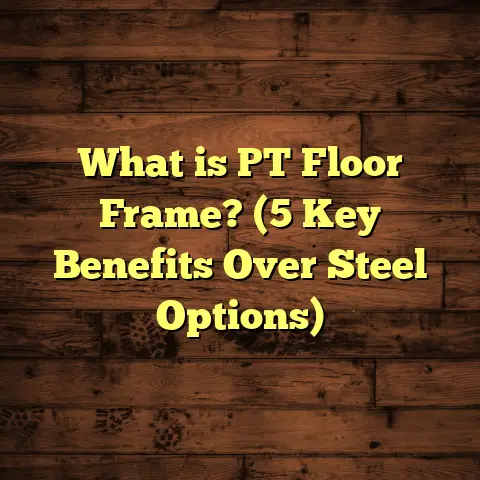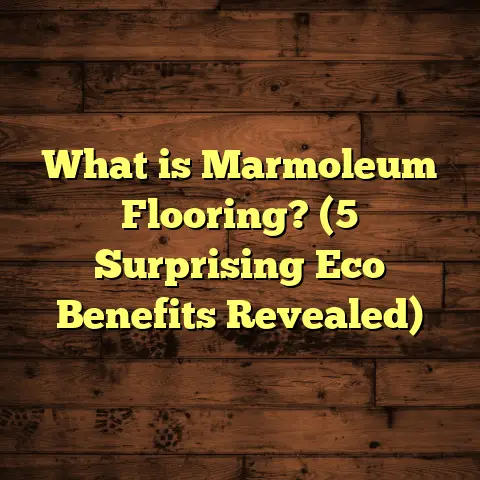What is a Hard Floor Surface? (5 Benefits for Homeowners)
Have you ever imagined what your home would feel like with floors that not only look stunning but also stand the test of time, daily wear, and spills? Floors that make your space warmer, cleaner, and easier to maintain? Choosing the right flooring can transform how you experience your home every day. If you’ve been wondering about hard floor surfaces, their benefits, and whether they might be the perfect fit for your living space, let’s talk through everything you need to know.
What is a Hard Floor Surface?
When I first started working as a flooring contractor over a decade ago, I noticed many people thought hard floors were just hardwood or tile. But hard floor surfaces go beyond that simple definition.
Put simply, a hard floor surface refers to any flooring material that offers a solid, firm walking surface rather than a soft or cushioned one like carpet or cork. These surfaces are typically rigid, durable, and able to withstand heavy foot traffic without significant damage.
Types of Hard Floor Surfaces
Here are some common types of hard flooring materials you’ll encounter:
- Hardwood: Natural wood planks like oak, maple, or walnut. Known for warmth and timeless appeal.
- Engineered Wood: A layered wood product that combines real wood veneer with plywood for stability.
- Laminate: Synthetic flooring that mimics wood or stone looks using photographic layers topped with a protective coating.
- Tile: Ceramic or porcelain tiles are popular for kitchens and bathrooms. They’re water-resistant and come in countless colors.
- Stone: Natural stone like marble, granite, slate, or travertine adds luxury and durability.
- Vinyl: Modern luxury vinyl planks (LVP) and tiles (LVT) mimic natural materials and offer water resistance.
- Concrete: Polished or stained concrete floors are increasingly popular for modern homes and industrial styles.
Characteristics That Make Floors “Hard”
- Durability: Hard floors resist dents, scratches, and wear better than soft floors.
- Low Compressibility: When you walk on them, they don’t bounce or compress underfoot.
- Ease of Cleaning: Spills don’t soak into them like carpets.
- Longevity: Many hard floors can last for decades with proper care.
Personal Insight
I remember early in my career helping a family choose between carpet and hardwood for their busy household. The wife was concerned about spills from two toddlers; the husband worried about scratching from their dog. After showing them samples and explaining maintenance routines, they opted for engineered hardwood with a durable finish. Years later, they told me they never regretted it — their floors looked great and stood up to all the chaos.
Five Benefits of Hard Floor Surfaces for Homeowners
Through years of installing and maintaining various hard floor surfaces in homes of all types — from small apartments to sprawling estates — I’ve seen firsthand the advantages these floors bring. The benefits go beyond just looks.
1. Durability and Longevity
If you’re thinking long term, durability is probably at the top of your list. Hard floors tend to last much longer than softer options like carpet or cork.
Why does durability matter so much?
Because flooring is an investment. Replacing floors can be expensive and disruptive. When you choose a hard floor surface, you’re minimizing the chances you’ll need a replacement anytime soon.
Hardwood Longevity
Solid hardwood floors are famous for lasting decades. According to the National Wood Flooring Association (NWFA), properly maintained hardwood can last 100 years or more.
I’ve restored 80-year-old hardwoods in historic homes that looked beautiful after sanding and refinishing. This longevity makes hardwood an attractive option for those who want to invest once and enjoy for life.
Tile and Stone Longevity
Tiles don’t easily wear out. Porcelain tiles are especially durable because they’re fired at high temperatures, making them dense and resistant to chipping or cracking.
Natural stone floors can last even longer but require sealing to prevent staining. I installed granite flooring in a client’s foyer that still looks flawless after 15 years of heavy use.
Laminate and Vinyl Lifespan
Laminate flooring typically lasts 10-20 years depending on quality and care. Luxury vinyl planks (LVP) and tiles (LVT) have similar lifespans but offer better water resistance.
For budget-conscious homeowners who want a durable option without breaking the bank, laminate and vinyl are excellent choices.
Data Point: A survey by the Home Innovation Research Labs found that 67% of homeowners who installed hardwood were satisfied with its durability after 10 years; satisfaction with vinyl was 58%, while carpet trailed at 38%.
2. Easy Maintenance and Cleaning
One of the biggest practical draws of hard floor surfaces is how easy they are to clean compared to carpet.
Why is cleaning so much easier?
Dust, dirt, hair, pet dander, and spills sit on top of hard floors rather than getting trapped inside fibers like carpet.
I often chat with clients who say they dread vacuuming carpets weekly or steam cleaning stains from upholstery-grade carpets. With hard floors, basic sweeping and mopping keep them looking fresh.
Maintenance Tips I Share
- Regular Sweeping or Vacuuming: Use a soft-bristle broom or vacuum designed for hard floors to remove grit that can cause scratches.
- Damp Mopping: Most hard floors respond well to damp mopping with mild cleaners. Avoid soaking floors excessively.
- Spot Cleaning: Wipe spills immediately to avoid staining (especially on wood or stone).
- Protective Pads: Place felt pads under furniture legs to prevent scratching.
Real-Life Example
A client with two energetic dogs switched their dining room from carpet to vinyl planks after repeated stains. They reported saving hours each month on cleaning efforts alone.
Research Insight: The Asthma and Allergy Foundation of America notes that homes with hard flooring have significantly lower levels of indoor allergens compared to carpeted homes.
3. Improved Indoor Air Quality
Did you know your choice of flooring affects the air you breathe indoors? This was a revelation when I first learned about it early on.
Carpets collect allergens like dust mites, pet dander, mold spores, and pollen. These can exacerbate asthma and allergy symptoms.
Hard floor surfaces don’t trap these particles; they’re easier to clean thoroughly.
Data on Indoor Air Quality
According to the Environmental Protection Agency (EPA), indoor air quality can be 2-5 times worse than outdoor air in some homes — often due to poor ventilation combined with particles trapped in carpets.
Homes with hard floors have been shown in studies to have lower airborne allergen levels. This leads to healthier living spaces for vulnerable groups like children or elderly family members.
When I worked with families who had allergy sufferers, switching from carpet to hardwood or tile was often recommended as part of an overall strategy to improve air quality.
4. Variety of Styles and Customization
One thing I love about hard floor surfaces is how many different looks they offer. Whether your style is classic elegance or contemporary minimalism, there’s likely a hard floor material that fits perfectly.
Hardwood Options
Hardwoods come in countless species, finishes, plank sizes, and colors. You can have anything from light maple with a matte finish to rich cherry wood with high gloss.
Custom stains allow you to match existing decor or create contrast.
Tile & Stone Variations
Tiles come in ceramic or porcelain with endless color options and finishes — glossy, matte, textured.
Natural stone adds unique patterns and textures no machine can replicate exactly.
I once installed hand-painted Spanish tiles that became the centerpiece of a client’s kitchen renovation — no two tiles were alike!
Laminate & Vinyl Styles
Modern laminate mimics wood grain almost perfectly at a fraction of natural wood’s cost.
Luxury vinyl comes in planks or tiles that replicate wood, stone, or even concrete looks—great for wet areas where water resistance matters most.
5. Increased Home Value
If you’re thinking about resale value or simply want your home to shine in the market, hard floor surfaces can help boost property appeal and price.
According to Remodeling Magazine’s Cost vs. Value Report:
- Replacing carpet with hardwood flooring yields an average return on investment (ROI) between 70-80%.
- Installing tile or engineered wood also delivers strong ROI figures compared to other upgrades.
I’ve worked closely with real estate agents who confirm homes featuring hardwood or tile floors tend to attract more buyers and sell faster than those with wall-to-wall carpet.
Diving Deeper: My Flooring Project Stories
Let me share a few stories from my years installing floors that illustrate these benefits vividly:
Story 1: The Allergy-Friendly Renovation
A family living in a humid climate called me because their daughter had severe allergies worsening every year. Their home had old wall-to-wall carpet throughout.
After evaluating their needs, we replaced carpets with engineered hardwood in living areas and porcelain tiles in bathrooms.
Six months later, the parents reported fewer asthma attacks and less sneezing indoors — validating what research says about indoor air quality improvement after switching to hard floors.
Story 2: A Busy Family’s Durable Solution
Another client had three kids under ten plus two large dogs running around constantly. They wanted something durable yet comfortable enough for children playing on the floor.
We recommended luxury vinyl planks (LVP) because of their water resistance and scratch-proof surface.
Two years later, their floors still looked new despite spills, muddy paws, and toys everywhere — proving LVP’s value as a resilient option for active families.
Technical Insights: Material Science Behind Hard Floors
Since you might be curious about what makes these materials so tough or easy to care for, here’s a quick overview:
- Hardwood: Made from dense tree species. The hardness varies depending on species measured by the Janka hardness scale (e.g., Hickory ~1820 vs Pine ~420).
- Engineered Wood: Combines layers of plywood for stability with a thin real wood veneer on top; less prone to warping than solid wood.
- Laminate: Constructed from fiberboard topped with photographic print film sealed under clear melamine resin—scratch-resistant but susceptible to water damage.
- Tile: Glazed ceramic or porcelain tiles have a vitrified surface making them highly resistant to moisture and scratches.
- Stone: Naturally dense minerals; porous types like limestone require sealing against stains.
- Vinyl: Made from synthetic polyvinyl chloride (PVC) layers; newer products include wear layers resistant to scratches and dents.
- Concrete: Can be polished or stained; extremely durable but may require sealing to prevent dusting and stains.
Cost Considerations: Budgeting for Hard Floor Surfaces
Pricing varies widely depending on material quality, installation complexity, location, and finish options.
Here’s a rough breakdown based on square footage including installation:
| Flooring Type | Estimated Cost per Sq Ft (Installed) |
|---|---|
| Hardwood | $8 – $15 |
| Engineered Wood | $6 – $12 |
| Laminate | $3 – $7 |
| Ceramic/Porcelain Tile | $5 – $15 |
| Natural Stone | $10 – $30 |
| Luxury Vinyl Plank | $4 – $9 |
| Polished Concrete | $3 – $10 |
Tips:
- Always budget extra for subfloor preparation or removal of old flooring.
- Quality matters: Cheaper materials may save money upfront but wear faster.
- Consider long-term costs: Maintenance frequency and potential repair expenses vary by material.
Using tools like FloorTally can help crunch these numbers based on your local labor rates and material costs so you get accurate estimates tailored to your project.
Installation Insights: What You Should Know Beforehand
Installation methods differ by flooring type:
- Hardwood & Engineered Wood: Typically nailed or glued down; some engineered options click together as floating floors.
- Laminate & Vinyl Planks: Usually floating floors clicked together without adhesive.
- Tile & Stone: Set with mortar on prepared subfloor; grout fills gaps between tiles.
- Concrete: Poured over subfloor; polished once cured.
Proper installation is critical to avoid issues like warping wood or cracked tiles later down the line. I always recommend hiring experienced installers unless you’re very confident tackling it yourself.
Comparing Hard Floors With Other Flooring Types
Here’s how hard floors stack up against other popular flooring types:
| Feature | Hard Floors | Carpet | Cork | Bamboo |
|---|---|---|---|---|
| Durability | High (10+ years) | Low-Medium | Medium | Medium-High |
| Maintenance | Easy (sweep/mop) | Requires vacuuming/cleaning | Moderate | Moderate |
| Allergy Friendly | Yes | No | Yes | Yes |
| Comfort Underfoot | Firm | Soft | Soft | Firm |
| Water Resistance | Varies (tile/vinyl very good) | Poor | Poor | Moderate |
| Installation Cost | Moderate-High | Low | Moderate | Moderate |
| Environmental Impact | Depends on material | Synthetic fibers | Renewable resource | Renewable resource |
Final Thoughts: Making Your Flooring Choice Work for You
Choosing flooring is more than aesthetics — it’s about how your home functions day-to-day. From my perspective as someone who installs floors regularly:
- If you want something that lasts decades,
- Is easy to clean,
- Supports healthy indoor air,
- Offers tons of style options,
- And boosts your home’s value,
then hard floor surfaces deserve serious thought.
Are you leaning towards solid hardwood for timeless beauty? Or maybe luxury vinyl planks fit your family’s active lifestyle better? Whatever you pick, make sure it aligns with your needs — budget-wise and lifestyle-wise — so you love living on it every day.
If you want me to help calculate costs based on your specific project or review pros and cons tailored exactly for your home type, just ask!





